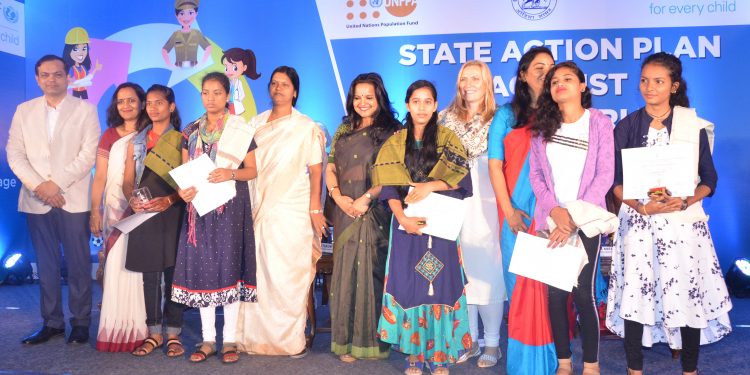Bhubaneswar: To make Odisha Child Marriage free by 2030, the state government, Thursday, launched a Strategic Action Plan (SAP) with the support of UNICEF and UNFPA.
The SAP was launched at a conference here organized on prevention of child marriage in Odisha.
The State Strategic Action Plan, to be implemented between 2019 and 2024, is a comprehensive and time-bound approach to accelerate actions to deal with the complexities of ending child marriage, said Women and Child Development Minister Tukuni Sahu, who inaugurated the conference.
The minister said the SAP is expected to serve as a “multi-layered and multi-sectoral intervention” that aims at completely eliminating child marriage by 2030.
Actions outlined in the strategic focus areas would be implemented with strong linkages among all stakeholders and coordination across all tiers of governance, synergistic and coordinated efforts by multiple departments would be the key to achieving the goal set to end child marriage, the minister said.
The key messages on child marriage were released by ‘Tiki Mausi’, the mascot of the Department of Women and Child Development.
Articulating her concern regarding the relatively high prevalence of child marriage in some districts, the minister said that there is an immediate need to take all possible steps by government, civil society, international bodies and communities.
“The families should take proactive action to stop this social evil which is strongly embedded in social practices,” the minister said.
The prevalence of child marriages among girls in Odisha was reported to be 21.3 percent against a national average of 26.8, whereas for boys it is only 11 per cent against the national average of 20.3 per cent (NFHS-4, 2015-16), said Deepa Prasad, State Programme Coordinator, United Nations Population Fund (UNFPA).
Though Odisha has witnessed a decline of nearly 16 and 11 percentage points (between NFHS 2005-06 and 2015-16), for girls and boys marrying before the legal ages of 18 and 21 years, respectively, still one in five women aged 20-24 years were married by the age of 18 in Odisha, she said.
Stating that the child marriage has a significant negative impact on an individuals physical, mental, emotional and social development and on education and economic opportunities, she said both girls and boys are affected by child marriage, but girls are affected in much larger numbers and with greater intensity.
Though the prevalence of child marriage has reduced substantially in Odisha, the pace of reduction has to be accelerated to ensure that the state is child marriage free by 2030, said WCD secretary Anu Garg.
Monika Nielsen, Chief of field office, UNICEF, Odisha and other dignitaries were also present during the launch of the SAP.
The department also felicitated six girls who had said “no” to child marriage as champions of ending child marriage. Orissa POST interacted with some of these brave girls and asked them about their dreams and aspirations.
Barsha Rani Sahoo of Kandhamal said when she was 16 year old her parents forced her to marry. She opposed to the idea and informed the child helpline. Now, at 17, Barsha says she wants to be a doctor for which she sought help from the government.
Women and Child Development minister Tukuni Sahu assured her that she will be provided with the help she needs to realize her dream.
Barsha also works with the local authority in creating awareness among the rural areas of her district gainst the ill effects of child marriage.
Sanjana Khila hails from Koraput. Sanjana’s father had died early and due to utter poverty, her mother stopped her education and had arranged to marry her off but after she protested, she managed to get away from being married off at an early age.
Subhalakshmi Sethy of Dhenkanal is a Plus II final year student. She wants to be a lawyer and fight for the rights of women andgirls.
Barsha Rani Muni of Keonjhar said her father works as a labourer in Surat. Due to poverty, Barsha’s family had planned to fix her marriage. When she got to know about it she contacted the child helpline and asked for help. She wants to share the message that child marriage hampers the overall well-being of a girl.







































